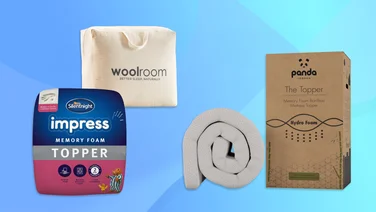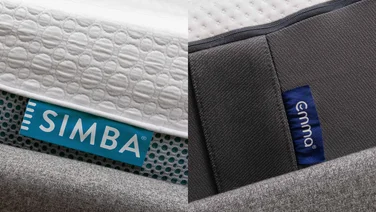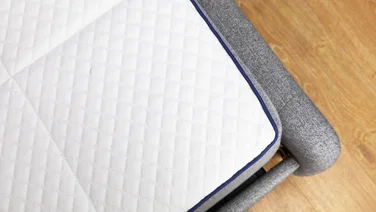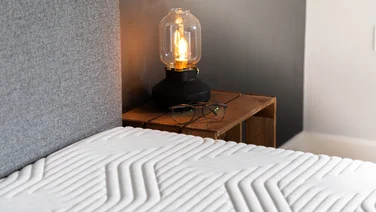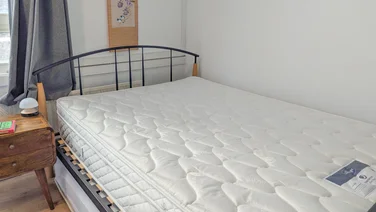To help us provide you with free impartial advice, we may earn a commission if you buy through links on our site. Learn more
- Best mattress: At a glance
- How we test mattresses
- The best mattresses you can buy in 2025
- 1. Best premium mattress
- 2. Best mattress for most people
- 3. Best mattress for hotel-quality comfort
- 4. Best premium cooling mattress
- 5. Most affordable mattress
- 6. Best mattress for a long trial period
- 7. Best value mattress
- 8. Best affordable mattress for hot sleepers
- 9. Best budget foam mattress
- 10. Best mattress for a choice of firmness options
- 11. Best mattress for back pain
- Where are the other mattresses?
- How to choose the best mattress for you

The best mattress isnt going to be the one that feels good when you try it for a few minutes. It takes time to adjust, and it will likely feel different after you’ve spent a month, or even a year, sleeping on it. Trialling a mattress for a sustained period is vital, something most manufacturers have realised – that’s why you get such a long grace period after you purchase a new mattress.
It’s also why we spend months at a time sleeping on the mattresses we review before we recommend them (or don’t). Weve tested around 40 mattresses in the past few years in this way – below, youll find a roundup of our absolute favourites, chosen after careful testing.
No time to read our mini reviews? Check out our at-a-glance list for a quick snapshot of our top picks.
Best mattress: At a glance
| Best premium mattress | Simba Hybrid Pro (From £799) | |
| Best for most people | Emma Hybrid Premium (From £389) | |
| Best mattress for hotel-quality comfort | Silentnight Premier Inn 2.0 mattress (From £609) |
Alternatively, scroll down to our buying guide if you need more information before you buy. If you’d like to know more about our testing processes – and why you can trust our recommendations – you can find that info immediately below.
How we test mattresses
We test our mattresses by sleeping on them, for at least two weeks and as long as three months. As we do so, there are a number of factors we take into account:
Comfort and firmness: Simply put, how does it feel to sleep on? Does it offer levels of plush comfort or is it better suited to those who prefer a firmer feel?
Temperature control: Some mattresses, all-foam ones in particular, might feel warmer than others, which makes them less suitable for those who are prone to overheating at night.

Motion isolation: If you share a bed with a partner, how disturbed are you by their movements during the night?
Mattress base: The foundation on which you put your mattress, whether that be a solid divan base, sprung slatted bed or even the floor, will impact how a mattress feels beneath you. We do our best to take this into account when were testing mattresses.
Value for money: Last but not least, how much you spend on a mattress is very important. Weve tested products across a wide range of price points, many of which also offer generous trial periods and money-back guarantees.
The best mattresses you can buy in 2025
1. Best premium mattress

Simba Hybrid Pro Mattress
Price when reviewed: From £799 (single) | Check prices at Simba
- Great for& its cool and comfortable wool layer
- Not so great for& sleepers on a budget
The Simba Hybrid Pro is one of the most luxuriously comfortable mattresses on this roundup as you’d hope, given the price tag. Our reviewer was particularly impressed with the uppermost wool comfort layer, which offered better temperature regulation than the foam used in most hybrids.
The mattress also adds an additional layer of microsprings compared to the original Simba Hybrid, which makes it both bouncy and more breathable. We found the mattress exceedingly comfortable in a range of sleeping positions. In fact, our reviewer liked it so much that they didnt want to go back to using their regular mattress.
The fact the Hybrid Pro comes with a 200-night trial rather than the 100 nights offered by some of its rivals also means you have the luxury of being able to try it for more than six months before making a decision. Although, as youll quickly find out further down the roundup, Simba is not unbeaten on trial period length.
We also gave five-star reviews to Simbas Luxe and Ultra mattresses. Each one of these is more expensive than the last. But if money is no object, they are well worth checking out.
| Key features | |
|---|---|
| Type | Hybrid |
| Needs turning? | Rotate once/month for the first six months; once every 3/6 months thereafter |
| Sizes | Single to king, arrives vacuum-packed |
| Trial period | 200 nights |
2. Best mattress for most people

Emma Hybrid Premium
Price when reviewed: From £389 (single) | Check prices at Emma
- Great for& a cool and comfortable sleep
- Not so great for& those who prefer a softer mattress
Many mattresses claim to offer the best of both worlds comfortable yet supportive, cosy yet cool without quite delivering on the promise. In our testers opinion, however, the Emma Hybrid Premium genuinely hits every mark. This sumptuous mattress uses a higher proportion of springs than other hybrid mattresses, and the result is a lovely balance of comfort, breathability and ergonomic support.
Our reviewer noted that the extra-tall 18.5cm pocket springs help the Hybrid Premium do an excellent job of absorbing and isolating movement, even when sharing with a restless partner. The springs also allow a level of airflow thats rare in a bed-in-a-box mattress, avoiding the dreaded clamminess you often get with memory foam.
Admittedly, the mattress is a little on the firmer side (and wed argue firmer than the medium-firm label that the Emma gives it) so those who prefer a softer sleep may need a mattress topper for optimum comfort.
The Hybrid Premium comes with a 200-night trial, and theres even a removable cover thats adept at wicking away moisture from your skin which pops in the washing machine.
| Key features | |
|---|---|
| Type | Hybrid |
| Needs turning? | No |
| Sizes | Single to super king, arrives vacuum-packed |
| Trial period | 200 nights |
3. Best mattress for hotel-quality comfort

Silentnight Premier Inn 2.0 mattress
Price when reviewed: From £609 (single) | Check prices at Premier Inn
- Great for& support, particularly at the edges
- Not so great for& people who prefer a softer mattress
The Silentnight Premier Inn 2.0 Mattress is extremely supportive. In fact, I found I could lie right at the edge of the mattress without feeling like the whole thing was going to buckle under me a niche use case perhaps, but still an impressive and uncommon string to this mattress’ bow.
Almost identical to the mattresses youll find in Premier Inn hotels, this Silentnight mattress is made up of a pocket sprung base with a pillow top comfort layer of polyester hollowfibre and Geltex foam. It’s a generous 28.5cm deep, which largely explains the unrivalled level of support.
This does mean the Premier Inn 2.0 is on the firmer side, so those of you who – like me – prefer a softer mattress should take note. However, I found in testing that I adjusted quickly to the firmness and ended up appreciating the support and level of comfort on offer.
Pillow top mattresses such as this one can’t be flipped, but if youre worried about wearing out the top layers unevenly, you can still rotate it a task made easier thanks to the mattress side handles.
| Key features | |
|---|---|
| Type | Hybrid |
| Needs turning? | No |
| Sizes | Single to super king, arrives flat |
| Trial period | N/A |
4. Best premium cooling mattress

Emma Hybrid ThermoSync
Price when reviewed: From £759 | Check price at Emma
- Great for& keeping cool at night
- Not so great for& smaller budgets
Memory foam is a notorious conductor of heat. Emma aims to combat this with its NextGen Cooling mattress. In addition to its layers of foam and extra-tall 18.5cm pocket springs, Emma has added a ThermoSync foam layer, designed to keep you cool throughout the night.
Bearing in mind that no mattress can actively cool you down, the Hybrid ThermoSync did a great job in our temperature regulation tests. Our tester found it softer than the Hybrid Premium, yet its combination of foam and springs doesnt fail to deliver a decent level of support.
Its not the cheapest option at £1,259 in a king size, but you might be able to find it discounted in one of Emmas promotional sales. Its also worth noting that its not the easiest mattress to actually find on Emmas website. Youll need to click on the Luxe Cooling Mattress, then specify the Hybrid ThermoSync from there.
Read our full Emma Hybrid ThermoSync review
| Key features | |
|---|---|
| Type | Hybrid |
| Needs turning? | No |
| Sizes | Single to super king, arrives vacuum-packed |
| Trial period | 200 nights |
5. Most affordable mattress

Origin Hybrid Mattress
Price when reviewed: From £277 (single) | Check prices at Origin
- Great for& sleepers who need ample support
- Not so great for& lighter sleepers who are after more softness
Sneaking in at under £500 for a single and rising to £719 for a king size, Origins Hybrid mattress is an affordable option (albeit not quite a “budget” one) that impressed our reviewer enough to earn it the maximum five stars in her full review. It has just enough softness for those who favour a more cushioned sleeping surface, while also delivering the kind of ergonomic support preferred by firm mattress enthusiasts. In our opinion, a comfortable all-rounder, and at a great price too.
Like many newer hybrid mattresses, the Origin Hybrid contains a grid-based layer designed to optimise back support and a temperature-control layer to keep you cool while you sleep. Theres also a solid foam layer for extra support where needed, even right at the edge of the mattress, and a layer of pocket springs whose innovative tapered design offers greater support the further you sink into the mattress.
Read our full Origin Hybrid Mattress review
| Key features | |
|---|---|
| Type | Hybrid |
| Needs turning? | No |
| Sizes | Five sizes from single to super king |
| Trial period | 200 nights |
6. Best mattress for a long trial period

Nectar Essential Hybrid Mattress
Price when reviewed: From £349 (single) | Check prices at Nectar
- Great for& the indecisive
- Not so great for& those who want a removable top cover
Nectars affordable Essential Hybrid offering is thinner than some of the brands other mattresses: the Nectar Premier, for instance, is 28cm while the Essential is 25cm. That aside, our reviewer found it still offered plenty of comfort and support as well as decent motion isolation, praising it as an excellent medium-firm option in her full-length review.
The real stand out feature with a Nectar mattress though, is the generous 365-night trial period. You get a whole year to try it out, before the end of which you can return it for a full refund if you dont agree with our five-star Best Buy award.
As far as value for money is concerned, Nectars Essential Hybrid undercuts many of its bed-in-a-box rivals on price. Following a recent restructuring of the brands price model, it starts at just £349 in a single and rises to just £599 for a super king. Its one of the cheapest hybrids weve reviewed.
Read our full Nectar Essential Hybrid mattress review
| Key features | |
|---|---|
| Type | Hybrid |
| Needs turning? | Unspecified |
| Sizes | Single to super king; arrives vacuum-packed |
| Trial period | 365 nights |
7. Best value mattress

Panda Hybrid Mattress
Price when reviewed: From £649 (single) | Check price at Panda
- Great for& firm support
- Not so great for& ease of cover removal
London based bedding brand Panda currently has two mattresses to its name: the Hybrid Bamboo Mattress and the Hybrid Bamboo Mattress Pro. The regular Hybrid is actually the brands second mattress: made up of seven layers including pocket springs and bamboo-infused foam, with a completely removable outer layer that can be machine washed.
Our reviewer found the Panda Hybrid supportive, if a little too firm for her preferences. Edge support is excellent, as is temperature regulation. One downside comes at the expense of the removable cover. As our reviewer said: Its handy to be able to wash the whole surface of your mattress, but removing the entire thing by sliding it off the foam inside is a cumbersome process. Getting it back on isnt any easier, either.
This didnt get in the way of the Panda Hybrid Bamboo Mattress getting a five-star Best Buy review, though. Its also much more affordable than its Pro predecessor, at £889 in a king size (compared to £1,390). And you get a 100-night home trial to decide whether or not its right for you.
Read our full Panda Hybrid Bamboo Mattress review
| Key features | |
|---|---|
| Type | Hybrid |
| Needs turning? | No |
| Sizes | Single to super king (including EU sizes) |
| Trial period | 100 nights |
8. Best affordable mattress for hot sleepers

Otty Pure Hybrid Bamboo and Charcoal
Price when reviewed: From £525 (single) | Check prices at Otty
- Great for& those who are prone to getting hot at night
- Not so great for& those who need a lot of time to decide whether a mattress is right for them
The Otty Pure Hybrid is a medium-firm mattress that strikes a great balance between comfort and support: our reviewer found that it fit in the sweet spot as a great option for both back sleepers and side sleepers. Those who like to make the most of all available bed space will be pleased to know that the mattress offers great edge support too.
Another thing that the Otty Pure Hybrid excels at is temperature regulation. Whether this is credit to the infusion of bamboo and charcoal (materials that are often marketed as having cooling and moisture-wicking properties) or just the overall design of the mattress, our reviewer was very impressed so much so that he dubbed it the coolest-feeling bed-in-a-box mattresses Ive tested to date.
Ottys trial period isnt quite as lengthy as the ones offered by other brands, but 100 nights is still a good amount of time to try a mattress out.
Read our full Otty Pure Hybrid Bamboo and Charcoal review
| Key features | |
|---|---|
| Type | Hybrid |
| Needs turning? | Once a month for the first 12 months; once every three months thereafter |
| Sizes | Single to super king; plus EU sizes |
| Trial period | 100 nights |
9. Best budget foam mattress

Dormeo Memory Plus
Price when reviewed: From £389 (single) | Check prices at Dormeo
- Great for& a foam option for the spare room
- Not so great for& those who want a thicker mattress
The Dormeo Memory Plus has a 140mm foam core with a 30mm memory foam top layer, so its a lot thinner than some other mattresses weve reviewed. Its a bit softer than average but, despite this thinness, we found the Memory Plus offers good levels of support.
If you sleep on your back and have struggled to find something suitable, this mattress may well hit the mark, as it might for people who are prone to moving around a lot in the night and dont want to disturb their partner. Best of all, though, is its remarkably low price which is even cheaper during one of Dormeos online sales. In our experience, deals seasons such as Black Friday are the best times to look out for a discounted Memory Plus mattress.
Of course, that thin design has a couple of downsides. During testing, we did notice that fitted sheets have some slack. But on the other hand rotating it isnt too difficult as its not very heavy. All in all, youll be very hard pushed to find anything better at this impressively low price.
Read our full Dormeo Memory Plus mattress review
| Key features | |
|---|---|
| Type | All-foam |
| Needs turning? | No |
| Sizes | Five sizes from single to super king, arrives vacuum-packed |
| Trial period | 60 nights |
10. Best mattress for a choice of firmness options

Eve Wunderflip Premium Hybrid
Price when reviewed: From £999 (double) | Check prices at Eve
- Great for& people who want a choice of firmness options
- Not so great for& tight budgets
The unique feature of Eves Wunderflip mattresses is that they can offer a choice of firmness, by flipping the mattress and fastening the foam comfort layer to your preferred side: softer or firmer.
Although our reviewer found that there wasnt a huge difference between both sides (in fact, if you prefer a very firm mattress, you may find it too soft on either side), they still called the Wunderflip Premium Hybrid more than a flippy gimmick in their full-length review. Wed argue its accurate to describe the sides as medium-soft and medium-firm, though both are comfortable and supportive. The Wunderflip Premium Hybrid also offers decent motion isolation, and edge support is improved compared to the brands previous Premium Hybrid mattress.
The only other thing we should point out is that it can take quite a while to full expand after unpacking (days according to our reviewer), so make sure you allow it enough time before sleeping on it.
Read our full Eve Wunderflip Premium Hybrid review
| Key features | |
|---|---|
| Type | Hybrid |
| Needs turning? | No |
| Sizes | Double to super king |
| Trial period | 200 nights |
11. Best mattress for back pain

Dreams Dream Team Romsey Pocket Sprung Mattress
Price when reviewed: From £429 (single) | Check prices at Dreams
- Great for&orthopaedic support to help ease aches and pains, great temperature regulation
- Not so great for&too firm for lightweight sleepers, particularly side sleepers
Not only is the Dreams Romsey mattress very well priced (a king size retails for £579) but the firm orthopaedic support it offers can make a real difference to back pain sufferers. Lower back pain sufferers in particular will appreciate the firm lumbar support on the Romsey, which ensures that spines are kept aligned and comfortable. We think the mattress is best suited to average and heavier weight sleepers, who will get plenty of cushioning comfort from the top layers of the mattress, with support provided by the coils underneath.
In the main, we think most lightweight sleepers may find the Romsey just a little too firm, particularly if they sleep on their side. The mattress uses a fairly simple hybrid design and the fact that it doesnt have masses of foam means that the Romsey is also a good choice for hot sleepers, who shouldnt overheat through the night. Youll get a 100-night trial and 1-year warranty with the bed, plus free shipping to your door. For an extra £29, you can have the mattress delivered to a room of your choosing, which wed recommend you take advantage of. Overall, this is a great choice for those on a smaller budget along with back pain sufferers.
Read our full Dreams Dream Team Romsey mattress review
| Key features | |
|---|---|
| Type | Spring and foam hybrid |
| Needs turning? | It’s recommended you rotate the mattress regularly |
| Sizes | Single to super king |
| Trial period | 100 nights |
Where are the other mattresses?
For the sake of offering you the best of the best in our roundup above, the mattresses weve featured are ones that earned five stars and Best Buy awards when we initially reviewed them. That said, there are plenty of other mattresses weve reviewed favourably and would still recommend.
1. Otty Original Hybrid: A great firm option
While its corner support could be improved, Ottys Original Hybrid is a great hybrid mattress particularly if you prefer a firmer feel. Admittedly, its creeped up in price over the years since we first reviewed it. But at £800 in a king size, its still more affordable than a number of its rivals.
2. Nectar Memory Foam Mattress: An all-foam mattress with a year-long trial
As with Essential Hybrid featured in our roundup, you also get Nectars standout year-long trial with the brands all-foam offering. The 26cm thick Nectar mattress is comfortable and supportive but it can soften up as it gets warmer during the night.
3. Ergoflex 5G: A supportive foam mattress
Ergoflexs all-foam 5G mattress is supportive and comfortable, though side sleepers might find that it could do with a bit more give. It offers very decent temperature regulation, too. One downside is Ergoflexs short 30-night trial period.
4. Hypnia Supreme: A comfortable foam mattress for a range of sleeping positions
The all-foam Hypnia Supreme is well-suited to a range of sleeping styles, while also offering excellent motion isolation. It feels supportive for an all-foam mattress but if you prefer a bit of bounce, then youre better off opting for a sprung or hybrid model.
How to choose the best mattress for you
What types of mattresses are available?
Before you look for a mattress, consider the different types on the market:
- Traditional pocket sprung: These are made up of layers of springs encased in fabric, alongside materials such as wool. Before the era of the bed-in-a-box, you could expect many mattresses to be of this variety
- Memory foam: Synthetic foam mattresses are popular for their ability to mould to your body, providing pressure point relief and thus being a good option for those who suffer from aches and pains. One common drawback is that memory foam absorbs heat, so can be uncomfortable for those prone to overheating at night. Another type of foam is latex, which, unlike memory foam, is a natural material and may be better for hot sleepers. For a more in-depth rundown on foam, check out our memory foam guide
- Hybrid mattresses: A combination of pocket springs (either full size or micro pocket springs) and memory (often alongside other materials) offers a best-of-both-worlds approach. Many of our favourite and most highly-reviewed mattresses are hybrids
What is a bed-in-a-box mattress?
We throw this term around a lot when talking about many of the mattresses we review. A bed-in-a-box mattress is, as the name suggests, a mattress that arrives rolled up and vacuum sealed in a box. This can be very convenient, especially if your living conditions make mattress deliveries cumbersome. Bed-in-a-box mattresses will take a little time to fully expand when you unwrap them, so be sure to check the manufacturers recommendations on how long you should wait before you can sleep on it.
Does a good mattress need to cost a lot?
As weve said, weve tested mattresses across a range of price points here at Expert Reviews, from £420 to £1,329 (king size). You can spend an awful lot of money on a new mattress, particularly when it comes to brands like Simba, but there are also plenty of affordable memory foam and hybrid mattresses out there. Weve aimed to cater to a range of budgets in our roundup below.
What else do I need to consider?
Buying a new mattress? You may also want to think about your current bed too. Weve already pointed out that your bed base will have an impact on how your mattress will feel, and buying a bed will come with its own set of considerations. For instance, the curved slats on a sprung-slatted bed frame will make a mattress feel a little less firm.Another thing to consider is mattress deals. Most bed-in-a-box brands regularly offer promotional sales, admittedly to such an extent that you will rarely see them at full price. In any case, we quote the full price in our mini reviews below, as well as highlighting some of the best deals on offer.
And what about trial periods? You no longer need to visit your local showroom if you want to try a mattress out before committing to the cost. Almost all bed-in-a-box brands offer generous trial periods, allowing you to try the mattress out at home (in some cases for as long as a whole year). Dont like it? No problem: simply return it for a full refund.


